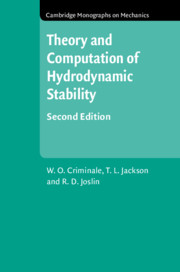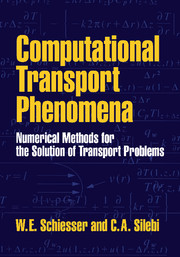Refine search
Actions for selected content:
5486 results in Thermal-fluids engineering
Appendix C - Solutions to Exercises
-
- Book:
- Theory and Computation in Hydrodynamic Stability
- Published online:
- 22 November 2018
- Print publication:
- 06 December 2018, pp 413-516
-
- Chapter
- Export citation
12 - Flow Control and Optimization
-
- Book:
- Theory and Computation in Hydrodynamic Stability
- Published online:
- 22 November 2018
- Print publication:
- 06 December 2018, pp 351-388
-
- Chapter
- Export citation
Preface to the Second Edition
-
- Book:
- Theory and Computation in Hydrodynamic Stability
- Published online:
- 22 November 2018
- Print publication:
- 06 December 2018, pp ix-x
-
- Chapter
- Export citation
1 - Introduction and Problem Formulation
-
- Book:
- Theory and Computation in Hydrodynamic Stability
- Published online:
- 22 November 2018
- Print publication:
- 06 December 2018, pp 1-25
-
- Chapter
-
- You have access
- Export citation
11 - Direct Numerical Simulation
-
- Book:
- Theory and Computation in Hydrodynamic Stability
- Published online:
- 22 November 2018
- Print publication:
- 06 December 2018, pp 316-350
-
- Chapter
- Export citation
5 - Stability of Compressible Flows
-
- Book:
- Theory and Computation in Hydrodynamic Stability
- Published online:
- 22 November 2018
- Print publication:
- 06 December 2018, pp 128-167
-
- Chapter
- Export citation
Appendix B - Numerical Methods
-
- Book:
- Theory and Computation in Hydrodynamic Stability
- Published online:
- 22 November 2018
- Print publication:
- 06 December 2018, pp 401-412
-
- Chapter
- Export citation
Contents
-
- Book:
- Theory and Computation in Hydrodynamic Stability
- Published online:
- 22 November 2018
- Print publication:
- 06 December 2018, pp v-viii
-
- Chapter
- Export citation
9 - Nonlinear Stability
-
- Book:
- Theory and Computation in Hydrodynamic Stability
- Published online:
- 22 November 2018
- Print publication:
- 06 December 2018, pp 259-286
-
- Chapter
- Export citation
3 - Temporal Stability of Viscous Incompressible Flows
-
- Book:
- Theory and Computation in Hydrodynamic Stability
- Published online:
- 22 November 2018
- Print publication:
- 06 December 2018, pp 76-97
-
- Chapter
- Export citation
Author Index
-
- Book:
- Theory and Computation in Hydrodynamic Stability
- Published online:
- 22 November 2018
- Print publication:
- 06 December 2018, pp 544-548
-
- Chapter
- Export citation
10 - Transition and Receptivity
-
- Book:
- Theory and Computation in Hydrodynamic Stability
- Published online:
- 22 November 2018
- Print publication:
- 06 December 2018, pp 287-315
-
- Chapter
- Export citation
2 - Temporal Stability of Inviscid Incompressible Flows
-
- Book:
- Theory and Computation in Hydrodynamic Stability
- Published online:
- 22 November 2018
- Print publication:
- 06 December 2018, pp 26-75
-
- Chapter
- Export citation

Theory and Computation in Hydrodynamic Stability
-
- Published online:
- 22 November 2018
- Print publication:
- 06 December 2018

Computational Transport Phenomena
- Numerical Methods for the Solution of Transport Problems
-
- Published online:
- 12 October 2018
- Print publication:
- 13 August 1997
-
- Textbook
- Export citation

Gas Turbines
- Internal Flow Systems Modeling
-
- Published online:
- 25 September 2018
- Print publication:
- 13 September 2018
2 - Energy
-
- Book:
- Thermodynamics
- Published online:
- 15 June 2019
- Print publication:
- 20 September 2018, pp 16-31
-
- Chapter
- Export citation
Remembering Bill Reynolds
-
- Book:
- Thermodynamics
- Published online:
- 15 June 2019
- Print publication:
- 20 September 2018, pp xx-xx
-
- Chapter
- Export citation
Dedication
-
- Book:
- Thermodynamics
- Published online:
- 15 June 2019
- Print publication:
- 20 September 2018, pp v-vi
-
- Chapter
- Export citation
5 - Entropy and the Second Law
-
- Book:
- Thermodynamics
- Published online:
- 15 June 2019
- Print publication:
- 20 September 2018, pp 74-97
-
- Chapter
- Export citation
